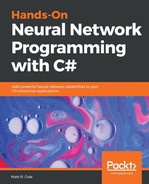Let's take a moment to clarify the difference between feed forward and back propagation. Once you understand this, you can visualize and understand much better how the entire neural network flows.
In neural networks, you forward-propagate data to get the output and then compare it with the real intended value to get the error, which is the difference between what the data is suppose to be versus what your machine-learning algorithm actually thinks it is. To minimize that error, you now must propagate backward by finding the derivative of error, with respect to each weight, and then subtract this value from the weight itself.
The basic learning that is being done in a neural network is training neurons when to get activated, when to fire, and when to be on or off. Each neuron should activate only for certain types of inputs, not all of them. Therefore, by propagating forward, you see how well your neural network is behaving and find the error(s). After you find out what your network error rate is, you back-propagate and use a form of gradient descent to update new values of the weights. Once again, you will forward-propagate your data to see how well those weights are performing, and then backward-propagate the data to update the weights. This will go on until you reach some minima for error value (hopefully the global minimum and not the local). Again, lather, rinse, repeat!
